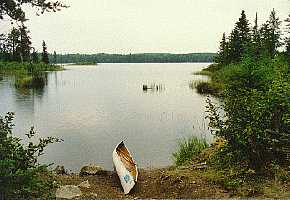FootstepsA Canoe Trip Mystery Story . . . My hand reaches for the zipper. Something jumps right onto the screen and I flinch back!. . . . |
We were tired. Dead tired. Just one more mile of paddling would bring us to a great island campsite in the middle of Kawnipi Lake. What a relief when it came into sight! Then, disappointment; someone else was already there.
Too tired to go looking for another nice site, we pull up to a worn out rocky island nearby. Mike sets up the tent and Dave starts a fire with the "welcome" wood left by the previous campers. I fill a bucket with water and dump in some beef barley stew. Two hours later, with the dishes washed and the fire watered down, we're sacked out and asleep.
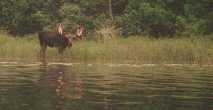 I know that like
most people, my dreams rehash the things that I saw and
felt during the day. Only if I'm awakened though, do I
remember anything. Maybe my dreams were of the portages
we made that day - the mud, the rocks and the canoe on my
shoulders. Maybe I look again at the powerful rushing
water we passed as we made our way down the falls chain
from Saganagons. Perhaps it was the moose that we saw,
quietly munching plants near a marshy shore that make my
eyes twitch as I sleep. On this night though, my sleep is
deep and long; I do not awaken.
I know that like
most people, my dreams rehash the things that I saw and
felt during the day. Only if I'm awakened though, do I
remember anything. Maybe my dreams were of the portages
we made that day - the mud, the rocks and the canoe on my
shoulders. Maybe I look again at the powerful rushing
water we passed as we made our way down the falls chain
from Saganagons. Perhaps it was the moose that we saw,
quietly munching plants near a marshy shore that make my
eyes twitch as I sleep. On this night though, my sleep is
deep and long; I do not awaken.
I'm drifting in that twilight between sleep and wakefulness when I hear the footsteps. Thump, thump, thump thump! I wake up quickly. Light fills the tent. It's morning.
Thump, thump, thump, thump, thump! Someone is walking in the grass around the back side of the tent. Dave or Mike must be up early. Maybe some coffee would be ready.
Thump thump thump. Three more footsteps. I glance to my left and notice that Dave's eyes are open - and there's Mike!.
"Did you hear those footsteps, Dave?"
"Yeah, I did. Is someone out there?"
"I heard them too" says Mike. I wonder who could be walking around in our campsite. It doesn't sound like four feet, it sounds like two feet. Who would come ashore early in the morning without calling out to us first?
"That sounded like someone walking around, didn't it?" Mike and Dave agree.
Stiff and sore, I wiggle out of my sleeping bag and pull on my shoes. After shaking the bug screen to knock off the clinging mosquitoes, I unzip the tent and crawl out. The sun is up and the September sky is cloudy but bright.
There's no one in sight!
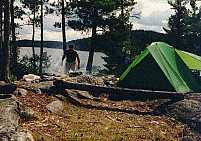 I start walking around the
island. First to the miserable landing where we pulled up
last evening. There's no extra canoe. Maybe it's a moose,
bear or deer that we heard. I climb up to the highest
part of the island. This island has been camped on so
long that the trees are pretty thin, and I can see all
the way to the lake in most directions. Nothing! Maybe
someone stopped, walked around, and left. I completely
circle the island, looking in each direction. Nothing is
paddling or swimming away. I even hang my head over a
steep rock face, on the off-chance that a canoe is hidden
there. Nope! I search for footprints in the moist soil
near the parts of the island where someone or something
could have come ashore. I find none. I try to think of
something that could have made the footstep sounds we all
heard, but I draw a blank. Haunted Island? I laugh as I
think about it. By now, Dave and Mike are up and we begin
another great day in Quetico Park, Ontario.
I start walking around the
island. First to the miserable landing where we pulled up
last evening. There's no extra canoe. Maybe it's a moose,
bear or deer that we heard. I climb up to the highest
part of the island. This island has been camped on so
long that the trees are pretty thin, and I can see all
the way to the lake in most directions. Nothing! Maybe
someone stopped, walked around, and left. I completely
circle the island, looking in each direction. Nothing is
paddling or swimming away. I even hang my head over a
steep rock face, on the off-chance that a canoe is hidden
there. Nope! I search for footprints in the moist soil
near the parts of the island where someone or something
could have come ashore. I find none. I try to think of
something that could have made the footstep sounds we all
heard, but I draw a blank. Haunted Island? I laugh as I
think about it. By now, Dave and Mike are up and we begin
another great day in Quetico Park, Ontario.
Kawnipi Lake has the perfect combination of size, variety and remoteness. Most visitors to Quetico are from the American side of the border, and to reach Kawnipi from the south or east requires at least nine portages. The portages keep casual visitors away, since an entire day is usually required to travel in or out. Most of the portages run next to the chain of falls that lead from the southwestern shore of Lake Saganagons to the southeast shore of Kawnipi.
The trip down the falls chain is both physically demanding and beautiful. If you enter the falls chain from Saganagons, you've already tasted a few portages. But as you near the end of the channel leading to the first falls, you encounter a new sensation. The channel turns to the right, and your canoe begins to speed up as the current takes you. Here, if it is your first time down the chain, you may again look carefully at your map. Yes, the portage is definitely shown on the left. The ominous words "Dangerous Waters", written in large letters across the map sharpen your wits as you are pulled forward. You steer toward the left shore as the current quickens.
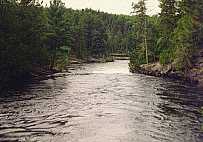 Now you can hear the sound of fast water. You
want to hug that left shore, but there are large rocks
that keep you farther out. Maybe there are drifting trees
snagged in the channel, forcing you further away from
safety. You listen to the rush of the water get louder as
the current pulls you faster and faster. There's the
portage! No, not yet. How close is the falls? Your mind
races and your eyes strain to see ahead. You might even
land on the left bank, not believing that the portage
could be so close to the roaring water. Just when you are
sure that you've gone too far, there is the portage
landing, plain as day! Wide enough for three canoes, a
slightly muddy beach opens up and you swing your canoe to
the left and land.
Now you can hear the sound of fast water. You
want to hug that left shore, but there are large rocks
that keep you farther out. Maybe there are drifting trees
snagged in the channel, forcing you further away from
safety. You listen to the rush of the water get louder as
the current pulls you faster and faster. There's the
portage! No, not yet. How close is the falls? Your mind
races and your eyes strain to see ahead. You might even
land on the left bank, not believing that the portage
could be so close to the roaring water. Just when you are
sure that you've gone too far, there is the portage
landing, plain as day! Wide enough for three canoes, a
slightly muddy beach opens up and you swing your canoe to
the left and land.
Although the portages of Quetico Park are well traveled, and cleared each spring by volunteers, they are not improved like some of the portages on the American side. Rocky, full of roots, sometimes deep with mud, they demand close attention to your feet. When I portage, I never lift my eyes to look around unless I stop. Walking slowly is a good idea, regardless of the load you are carrying. The day will come when something catches your foot, and if you are going too fast, you may go down. This happened to me once near the end of a solo trip on the American side. A stick caught my shoe and "pole vaulted" my foot so that I couldn't step down. I was lucky - my knee came down on a patch of soil, rather than the sharp edge of a rock.
The first portage up the falls chain has several landings. It's possible to take the short landing on the way down the chain, and sometimes on the way up, depending on the water level. You will have peace of mind if you take the longer portage. If you have time, walk the shore and see for yourself where you might put in next time. At the end of the fast water, you will be in a little bay, the next portage waiting just ahead with the landing behind a large rock. This one is short and flat. Things are looking better!
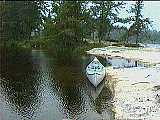
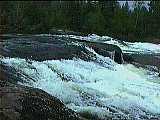 Your next portage
begins on a large, flat shore of solid rock. To your
left, the falls cascade into a wide scenic bay. The
waters crash in on one side, settle in the bay, then rush
out of a narrow channel. Near the narrows there is a
marshy area, and sometimes moose are seen crossing
here.
Your next portage
begins on a large, flat shore of solid rock. To your
left, the falls cascade into a wide scenic bay. The
waters crash in on one side, settle in the bay, then rush
out of a narrow channel. Near the narrows there is a
marshy area, and sometimes moose are seen crossing
here.
Just across the falls, on the opposite shore from the portage, there is a great campsite. Undamaged by the fire of '95, it still is green and protected. Make your way along a path near the back of this campsite, and you can walk out on a peninsula right to the base of the falls. Your ears will be filled with the rushing sound of fast water as the mist drifts and swirls around you.
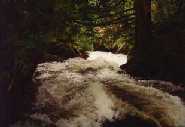 Each portage in
the chain offers a different view of the wilderness.
Carefully walk off the right side of the portage at the
beginning of Canyon falls. Watch your step; there's a
steep hill here, hidden by the brush. Far below, a small
part of the current crashes and swirls deep down in the
dense forest.
Each portage in
the chain offers a different view of the wilderness.
Carefully walk off the right side of the portage at the
beginning of Canyon falls. Watch your step; there's a
steep hill here, hidden by the brush. Far below, a small
part of the current crashes and swirls deep down in the
dense forest.
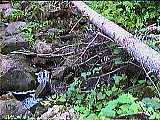 There's a small
creek that you must cross as you walk the Canyon Falls
portage. When you come to it, walk a little bit farther;
don't attempt to slide down the steep muddy slope. A
large log steadies you as you step from rock to rock
across the water. Stop here and look at where you are.
Ahead, the tenuous path rounds a hill and disappears into
twisted, fire blackened trees, Below, in a miniature
green valley, a small creek trickles between the rocks,
then disappears into the dense forest. Maybe the wind is
blowing and the trees above sway and knock and beckon.
There's a small
creek that you must cross as you walk the Canyon Falls
portage. When you come to it, walk a little bit farther;
don't attempt to slide down the steep muddy slope. A
large log steadies you as you step from rock to rock
across the water. Stop here and look at where you are.
Ahead, the tenuous path rounds a hill and disappears into
twisted, fire blackened trees, Below, in a miniature
green valley, a small creek trickles between the rocks,
then disappears into the dense forest. Maybe the wind is
blowing and the trees above sway and knock and beckon. 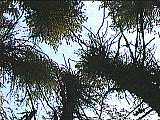 Maybe the sky is
gray, and the forest closes around you, dark, quiet and
mysterious. When you sleep at the end of your day, you
will be here again, for if you love the wilderness, these
special places are never forgotten. Canyon falls portage
ends on a steep, rocky landing. You will struggle to load
your canoe, then shove off into the rushing current that
sweeps you to the next portage...
Maybe the sky is
gray, and the forest closes around you, dark, quiet and
mysterious. When you sleep at the end of your day, you
will be here again, for if you love the wilderness, these
special places are never forgotten. Canyon falls portage
ends on a steep, rocky landing. You will struggle to load
your canoe, then shove off into the rushing current that
sweeps you to the next portage...
If you started late, or packed too heavily, you may camp on one of the island campsites in Kenny Lake. These sites are still green; they were not burned in the fire. If you make the final portage around Kenebus falls, your landing will be right next to the base of the falls. You'll have to speak up to be heard; the water is fast and noisy. The falls chain portages may leave you tired, but never bored. You will end up in the ever widening narrows that opens up to Kawnipi Lake.
The Bird lake fire of '95 burned much of the southeastern shores of Kawnipi. From the falls chain to the eastern shore of Kawa bay, almost all exposed timber is charred, though there are patches of untouched forest. Even the beautiful island that Dave, Mike and I wanted to camp on back in September of "93 is gone now. Half a mile to the west is the small worn island that we stayed on.
Dave starts our small gas burner and we have coffee and pancakes for breakfast. I begin putting up our 40 meter short-wave antenna. I'm a casual radio amateur and when I go more than a few portages into the park, I bring a small re-worked mobile transceiver, just in case someone gets hurt or sick. For Dave, amateur radio is a major hobby. He's contacted every country in the world from a small farm in Wisconsin. He's also traveled with several amateur radio expeditions, one to the frigid South Sandwich Islands.
Radio amateurs have special rules about what a country is. When an obscure country is defined, and the population of that country has few or no radio amateurs, an expedition may be formed by a team of proficient and adventurous operators. Traveling to the country, often halfway around the world, they operate one or more portable stations twenty-four hours a day. Amateurs from all over the world jam the airwaves, waiting their turn to contact the obscure "country". For a while, these adventurers are the most popular operators in the world, everyone wants to make contact.
Now I bring out the small battery powered radio and hook up the telegraph key and antenna.
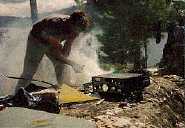 "How far do you think we could reach with
this little rig?" I ask Dave. Dave steps up to the
key and begins tuning near the end of the 40 meter band.
Soon he hears station VK3XU taking calls from Melbourne,
Australia. He waits for some of the more powerful
stations to finish their contacts. Ten minutes later,
Dave begins sending rapid code on the key. Drew, the
Australian operator, answers. They exchange signal
reports, and it's over. Dave records the details of the
contact, 07:24 CST, September 6th, 1993, Frequency: 7.005
Megahertz. Signal received, 459, sent, 559. For some
amateurs, making contact is everything, what is said is
superfluous. From our tiny rock in Quetico, Ontario,
we've said hello to someone in Australia. I'm amazed at
Dave's operating skill, and the skill of the distant
operator that picked out our tiny signal.
"How far do you think we could reach with
this little rig?" I ask Dave. Dave steps up to the
key and begins tuning near the end of the 40 meter band.
Soon he hears station VK3XU taking calls from Melbourne,
Australia. He waits for some of the more powerful
stations to finish their contacts. Ten minutes later,
Dave begins sending rapid code on the key. Drew, the
Australian operator, answers. They exchange signal
reports, and it's over. Dave records the details of the
contact, 07:24 CST, September 6th, 1993, Frequency: 7.005
Megahertz. Signal received, 459, sent, 559. For some
amateurs, making contact is everything, what is said is
superfluous. From our tiny rock in Quetico, Ontario,
we've said hello to someone in Australia. I'm amazed at
Dave's operating skill, and the skill of the distant
operator that picked out our tiny signal.
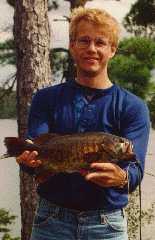 |
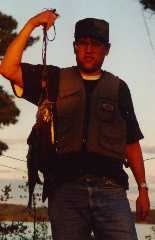 |
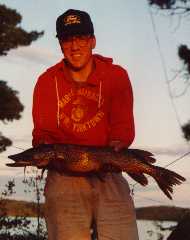 |
For the next two days, we fish, explore and enjoy the different bays of Kawnipi. Coming back from a trip on the last day, we find a large moose in full antlers roaming the island next to ours. Later that evening, the loons start crying out, first mournful, then quick and frantic. Once again my sleep is deep and undisturbed.
We wake up to a cloudy day. Worried about rain and bad weather, we decide to head back. Kawnipi can get rough when the wind comes up, but we are more concerned about portaging in the rain. Ten minutes after leaving our island, we turn around and watch the moose swim over and land. I think again of the footsteps, but I just as quickly shake my head. Surely I would have noticed a bull moose walking around! The rain does come, but not in a downpour. The portages are rough, but we make it through all of them by late afternoon.
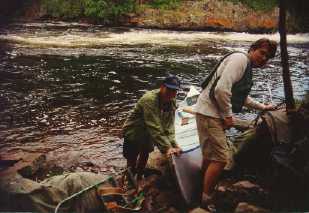 |
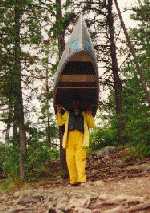 |
From the last portage, there is a small sheltered channel that leads to Saganagons. To get to the main route, and a campsite I have in mind, we must travel through a long reach between the northern shore of Saganagons and a large island. As we paddle through, we hear the wind pick up, and it starts to drizzle again.
There's a campsite on the north shore at the end of the reach, and when the southwest wind hits us, I consider taking it. We land to stretch and take a look. The campsite faces right into the wind. A nice breezy place on a calm day, it's no place to park with a rising wind and stormy weather coming in. We head southeast along the chain of islands that lead to Hunter Island portage. The paddling is hard and the water rough. We pass a small empty campsite, but there's a nicer one I'm headed for. Again, disappointment; someone has it already. Along the main routes, and only two portages out, campsites are often full by four O'clock. It's after six now, and I don't want to do another portage, so we head back to the small site behind us.
Rain is coming, so I quickly unload the wood we gathered at the last portage and get a fire going. Mike and Dave get the tent up, and I put up our fly in front of the tent, well sloped down so the wind won't grab it. I'm scheduled to send a message home on the radio, so I throw rocks over two trees and get the antenna up. Just as we finish, the rain hits. It rains harder than I thought it would, so I don't try to keep the fire going. Mike and Dave get into the tent and I crawl under the fly with a bucket of water, some dry stew and the gas burner. I've used this type of "kitchen" often in the past. My feet are already wet, and I don't want to change into my dry shoes while I'm still out in the rain, so I sit soggy, dirty unshaven and haggard. More out of habit than to keep any mosquitoes away, I clench the last half of my last cigar in my teeth. I am about as far away from the definition of "Chef" as I can possibly be, but I get no complaints from the diners as I pass bowls of hot stew into the tent.
Groping around in the dark and the rain, I get the last of our food hung up, turn over the canoe, and make sure all of the packs are closed and tucked under the fly. I strip off my rain suit, wet shoes and filthy pants before climbing into the tent. Rain drums on the tent fly, and the wind rises and falls. There is no lightning, though, so I hook up the radio and plug in headphones. Dave and Mike are already asleep, but I want to stretch this last night a little longer.
After sending off a "blind" message to my wife, Judy (she's not an amateur, so can only receive), I scan through the static on the 40 meter band, searching for signals. I'm tired, and my fingers are stiff and clumsy from paddling and portaging. Lying on my stomach in the middle of the wilderness, with rain pouring down and the wind rattling the tent, I hardly expect make contact. I go to the novice band to find someone sending slowly. Soon I hear a strong but painfully slow signal. The characters are run together, so that I have trouble copying the words, despite the slow speed. I answer, and soon am talking to Dale, KB9IPB, in Bangor, Wisconsin. I don't know if Dale understands where I am, but I understand his message when I receive "this is my first time on the air!" Dale is a brand-new amateur, and has just received his license to operate. By some quirk of fate, his first contact is me, calling from a small island in the middle of the wilderness. Dale thanks me for answering his call, and sends me "best wishes". I will always remember this call, and still keep the tattered notebook page where I wrote Dale's message.
Dave, Mike and I make the Hunter Island and Silver Falls portages the next day, and by mid afternoon are on the American point in big Saganaga Lake. It's windy, but the wind is coming from the west-southwest now, and will actually help us in our crossing. We wait on the American point for a front to go through. We watch the waters of big Sag turn angry as it does. Within 20 minutes, however, the worst wind is gone and we shove off.
I've made this last leg of the trip many, many times, but I'm about to learn another lesson from Saganaga. With my bearings, expected crossing times and landmarks clearly marked on my map, and with all of my past experience, I become over confident in my ability to find my way back. A strong wind is at our backs, and I am concerned that a large wave will overtake us from behind. We could take on a lot of water; the boat will not lift fast enough and a big one could break over the gunwale. I'm concentrating on the waves, and I don't realize that we are traveling twice as fast as usual. I must have misread one of our landmarks as we rushed eastward. An hour later I know that something is terribly wrong - I'm lost.
The problem is all in my head. I think that I must have turned too early, and in fact the wind has blown us far beyond where we normally go. Thinking that traveling south may lead us into a blind bay, I am reluctant to go too far. The wind is so strong that we can only dart from sheltered shore to sheltered shore. For close to two hours we try to figure out where we are.
I finally see a small fishing boat motoring north on the churning waves. The boat has the Superior-North Canoe Outfitters emblem on the bow; it's one of Earl Cypher's boats, and Earl is the man that supplied us with our canoe. I wave my paddle and the boat comes over to us. At the helm is Al Lyons, one of the most experienced guides around. Al must wonder what we are doing out so late on such rough water. He tells us to go south. I'm still so convinced that we are short of the channel we want that it's hard for me to mentally switch the picture. Al Lyons is a man who knows his way, however, and I'm immediately relieved. We follow Al's directions and pull up at Earl's landing just as darkness closes around us.
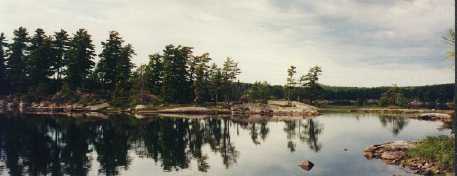 In June of '94, I
travel again to Kawnipi, but this time with my daughter
Diana and her friend Karen. Our route is different this
time, with different challenges and adventures. Much of
what we see will be changed by the fire of '95, but now
it is beautiful, mysterious, and serene.
In June of '94, I
travel again to Kawnipi, but this time with my daughter
Diana and her friend Karen. Our route is different this
time, with different challenges and adventures. Much of
what we see will be changed by the fire of '95, but now
it is beautiful, mysterious, and serene.
Half-way up the falls chain, near the end of our trip, we decide to make camp. There is a campsite at the portage into Wet Lake, and here we land and prepare for the night. The campsite lies between a small rapids and a swampy area. The cries of the loons are joined by the croaking of frogs. It is overcast, and no moon is showing as we zip the tent closed.
We were tired. Dead tired. Diana and Karen were settled in. I struggled to put on extra clothing against the cold of the night, then climbed into my bag. It was in that twilight between sleep and wakefulness that it began again.
Thump, thump, thump!
Footsteps!
I quietly sit up and find a flashlight. This time, I'm going to find out what's making that sound! I'll just slip outside without waking the girls and take a look.
I turn on the flashlight and shine it through the mosquito screen. My hand reaches for the zipper. Something jumps right onto the screen and I flinch back! Then I can't help it, I start laughing out loud.
"What's wrong?" Diana's voice is heavy with sleep.
"Come take a look" I shine the flashlight on the screen. Diana and Karen sit up and look. On the screen is a very large, very green frog!
"Go back to sleep, and tomorrow I'll tell you a story..."
![]()
More Canoe Stories
Copyright 1997 by James A.
Hegyi
http://www.canoestories.com/foot.html
